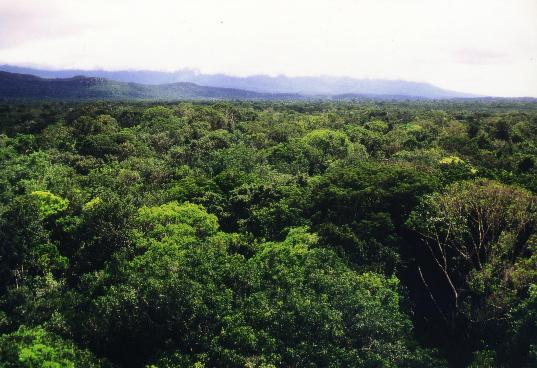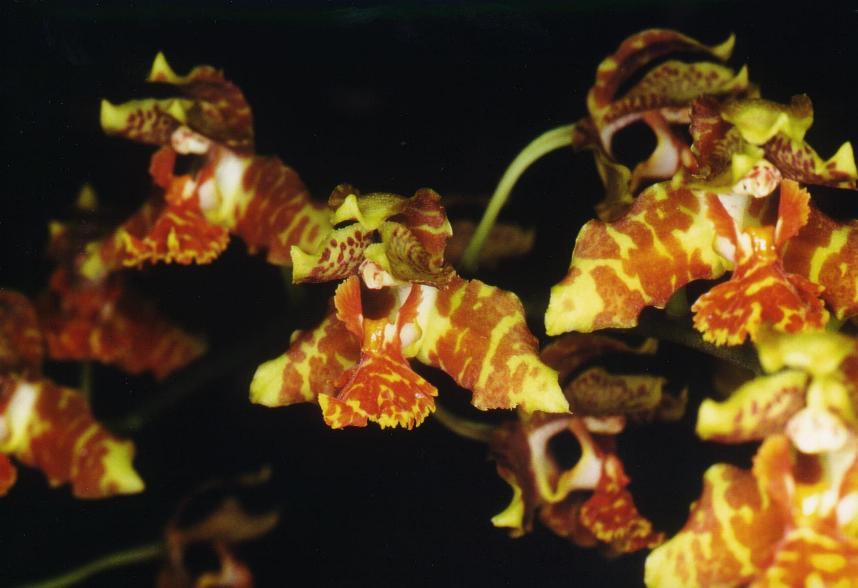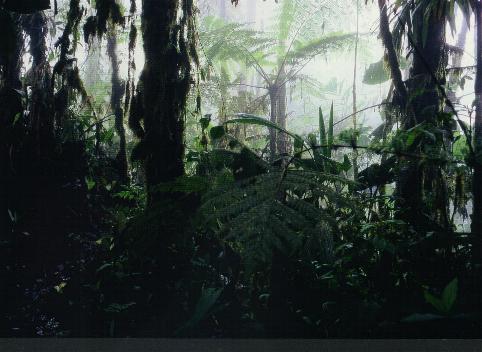Approximately 10% of all vascular plant species are epiphytes, plants
living on other plants without drawing water or nutrients from its living
tissue. In the tropics, epiphytic plants - mainly orchids, bromeliads and
Araceae - are a characteristic element of the vegetation.
 |
Full
of hidden wonders: the canopy of the tropical rainforest.
The
forest shown on this Photo, a lowland rainforest in southern Venezuela,
is one of the study sites of our project. (Photo: J. Nieder). |
 |
An
epiphyte from a south-american montane cloud forest: The orchid Bifrenaria
aurantiaca from Ecuador
(Photo:
J. Nieder). |
During the last decade the Botanical Institute of the University of Bonn
has been carrying
out various field studies and theoretical investigations based on detailed
evaluation of floras and inventories of epiphytes. The studies generally
enclose all systematic levels of epiphytic flora with special focus on
vascular epiphytes. Our aim is to contribute to the relatively scarce knowledge
on the structure and the dynamics of epiphytic plant communities of mainly
neotropical study sites in comparison to the terrestrial vegetation. Previous
studies in Bolivia (Ibisch 1996) and Ecuador (Rudolph et al. 1998) were
realized and a dissertation was carried out in various forest types
in Ruanda and Zaïre (Biedinger & Fischer 1996). Analysis of flora
literature with regard to Peru was published by Ibisch et al. (1996).
Furthermore our project group participates in the Surumoni crane project
of the Austrian Academy of Science studying the canopy of a lowland rain
forest in Southern Venezuela.
 |
An
instrument of canopy research in our project: the crane of the Surumoni
Projekt (upper Orinoco, Venezuela). |
Current study sites:
Venezuela:
- Río Surumoni crane project (lowland
rain forest, upper Orinoco river)
For more information please take a look at:
http://www.oeaw.ac.at
/~klivv/surumoni/welcome.html
http://139.18.174.1/surumo
ni/extern/index.htm
Ecuador:
- Otonga (mountain rain forest)
- Río Guajalito (mountain rain forest)
For each site various questions have to be answered:
How many epiphyte species are there, how is the epiphytic plant community
composed?
What factors determine species richness and community structure of epiphytes?
How do these communities change over time?
General scientific aimes are:
to provide a database with epiphyte inventories and species numbers of
various worldwide study sites, spatial distribution patterns, geographical
distribution and registration of abiotic conditions.
to explain the cause of diversity and distribution of epiphytes.
to elucidate the role of epiphyte diversity on total plant diversity and
to make understandable the consequences on total biodiversity.
to compare undisturbed and disturbed areas: bioindicative potential
of epiphytes, species conservation, concept for protection and use.
 |
The mountain rainforest
at Río Guajalito, Ecuador
(Photo: J. Nieder) |
Scientific Cooperations:
Venezuela:
-
Dr. Otto Huber, Universidad Simón Bolívar, Caracas
-
Ministerio del Ambiente y de los Recursos Naturales y Renovables (MARNR)
-
SADA-AMAZONAS
Ecuador:
-
Dr. Tjitte Devries, Pontificia Universidad del Ecuador,
Quito
-
Lic. Jaime Jaramillo, Pontificia Universidad del
Ecuador, Quito
-
Dr. Giovanni Onore, Pontificia Universidad del Ecuador,
Quito
-
Dr. Renato Valencia, Pontificia Universidad del Ecuador,
Quito
Others (selection):
-
Austrian Academy of Science, Vienna
-
KLIVV, Vienna
-
University of Leipzig
-
University of Mannheim
Funding of projects:
Venezuela: Deutsche Forschungsgemeinschaft:
"Epiphyten im Kronenbereich neotropischer Regenwälder - Struktur und
Dynamik einer Lebensgemeinschaft"
Ecuador: Volkswagen-Stiftung: "Epiphytische
Gefäßpflanzen in zwei ecuadorianischen Bergregenwäldern
und ihre Bedeutung für die Aufrechterhaltung des Artenreichtums von
Pflanzen und Tieren im Canopy"
Publications:
-
Barthlott, W., S. Porembski & J. Nieder, 1996: Biodiversität im
Fokus der Forschung: Tropische Inselberge und Epiphyten.- Akademie-Journal
2/95;
50-55.
-
Barthlott, W., J. Nieder, S. Engwald & V. Schmit-Neuerburg: Diversity
and abundance of vascular epiphytes: a comparison of secondary vegetation
and primary montane rain forest of the Venezuelan Andes. (in review)
-
Biedinger, N. & E. Fischer, 1996: Epiphytic vegetation and ecology
in central african forests (Rwanda, Zaïre).- ECOTROPICA 2;
p 121-142.
-
Engwald, S., Nieder, J., Barthlott, W. & M. Klawun, 1998: Epiphyten
und ihre räumliche Verteilung in einem amazonischen Tieflandregenwald
(Río Surumoni) in Venezuela.- In Dalitz,H., Haverkamp, M., Homeier,
J. & S.-W. Breckle (Ed.), 1998: Kurzbeiträge zur Tropenökologie.-
Bielefeld: BÖB 12, Abstract; p 56.
-
Ibisch, P., A. Boegner, Nieder, J. & W. Barthlott, 1996: How diverse
are neotropical epiphytes ? An analysis based on the "Catalogue of flowering
plants and gymnosperms of Peru".- Ecotropica 2 (1); p 13-28.
-
Ibisch, P., 1996: Neotropische Epiphytendiversität - das Beispiel
Bolivien.- Wiehl: Martina Galunder-Verlag; 357 pp.
-
Nieder, J., & Barthlott, W., 1992: Noch ein Amerika-Jubiläum:
Anmerkungen zu 500 Jahren Kenntnis neotropischer Epiphyten in Europa.-
Die Orchidee 43; p 241-243.
-
Nieder, J., Ibisch, P. L., & Barthlott, W., 1996: Biodiversidad de
epífitas: una cuestión de escala?- in: V Simposio de Botánica,
La Habana, Cuba, Abstract; p 73.
-
Nieder, J., Barthlott, W., Müller, U., Mutke, J., Novicki, C.,
Rauer, G.& Rudolph, D. (1998): Diversität terrestrischer und epiphytischer
Vegetation in Bergregenwäldern Ecuadors im Vergleich. - In Dalitz,H.,
Haverkamp, M., Homeier, J. & S.-W. Breckle (Ed.), 1998: Kurzbeiträge
zur Tropenökologie.- Bielefeld: BÖB 12, Abstract; p 130.
-
Nieder, J., P. L. Ibisch, et al. (1998). Biodiversidad
de epífitas - una cuestión de escala. Revista del Jardín
Botánico Nacional (La Habana, Cuba) XVII-XVIII, 59-62.
-
Nieder, J. and G. Zotz (1998). Methods of analyzing
the structure and dynamics of vascular epiphyte communities. Ecotropica
4,
33-39.
-
Rudolph, D., Rauer, G., Nieder, J. & Barthlott, W., 1998: Distributional
patterns of epiphytes in the canopy and phorophyte characteristics in a
western andean rain forest in Ecuador. - Selbyana 19(1), p. 27-33.
Diploma theses
-
Boegner, A. (1998). Diversität und Phytogeographie
der epiphytischen Angiospermen ausgewählter paläo- und neotropischer
Gebiete. Botanisches Institut Bonn.
-
Hemmer, V. (1998). Die Epiphyten eines anthropogen
beeinflußten Bergregenwaldes in den venezolanischen Anden. Botanisches
Institut Bonn.
-
Krause, P. (1998). Epiphyten im Canopy - Oberflächen,
Größen und fraktale Strukturen. Botanisches Institut Bonn.
-
Müller, U. (1997). Diversität epiphytischer
Moose eines westandinen Bergregenwaldes in Ecuador.Botanisches Institut
Bonn.
-
Nowicki, C. (1998). Diversität epiphytischer
und terrestrischer Pflanzen eines ecuadorianischen Bergnebelwaldes im Vergleich.
Botanisches Institut Bonn.
-
Rauer, G. (1995). Epiphytische Orchidaceae eines
westandinen Bergregenwaldes in Ecuador. Botanisches Institut Bonn.
-
Rudolph, D. (1995). Vaskuläre Epiphyten eines
westandinen Bergregenwaldes in Ecuador. Botanisches Institut Bonn.



